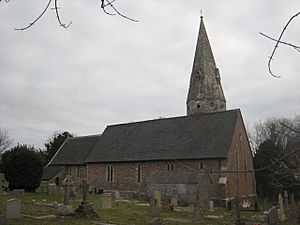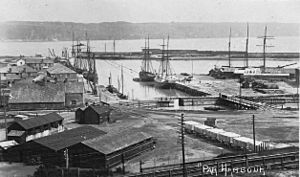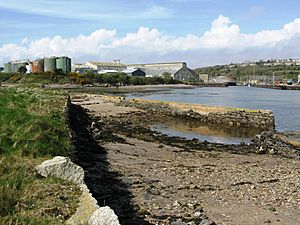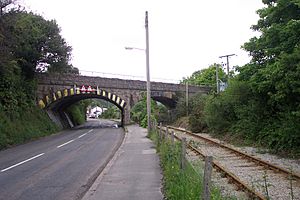Par, Cornwall facts for kids
Quick facts for kids Par
|
|
|---|---|
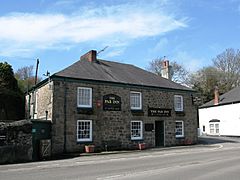 The Par Inn |
|
| Lua error in Module:Location_map at line 530: Unable to find the specified location map definition: "Module:Location map/data/Cornwall (mainland)" does not exist. | |
| OS grid reference | SX072536 |
| Civil parish |
|
| Unitary authority | |
| Ceremonial county | |
| Region | |
| Country | England |
| Sovereign state | United Kingdom |
| Post town | PAR |
| Postcode district | PL24 |
| Dialling code | 01726 |
| Police | Devon and Cornwall |
| Fire | Cornwall |
| Ambulance | South Western |
| EU Parliament | South West England |
| UK Parliament |
|
Par (Cornish: An Porth, meaning creek or harbour) is a village and fishing port located on the south coast of Cornwall, England. It's a busy place with a harbour that has been important for many years.
The village is part of the civil parish of Tywardreath and Par. However, some parts, like West Par and the docks, are in the parish of St Blaise. Par is about 3.5 miles (5.6 km) east of St Austell and has a population of around 1,600 people.
Par really started to grow in the early 1800s. This was when its harbour was built to help transport minerals like copper from nearby mines. Later, china clay became the main product shipped from Par. Even though less mining happens now, the harbour and old china clay drying sheds are still important parts of Par's history.
South of the village, you'll find Par Harbour and Par Sands beach. There's also a large holiday park for caravans there. Another smaller beach is at Spit Point, west of the harbour. If you're walking the South West Coast Path, it takes a detour through the village between these two beaches. Par has a one-way system of streets with various shops, a post office, and a pub.
Contents
Churches in Par
Par has a few interesting churches. The Anglican church of St Mary the Virgin at Biscovey was finished in 1849. It was mostly built using local reddish-coloured Biscovey slates. The area of Par became its own church parish in 1846, separating from St Blazey and Tywardreath parishes.
In the churchyard, there's an old stone cross shaft. It was moved there in 1896 from the main road. This stone is a special monument for a son of someone named Ullicus. The church was the first one designed by a famous architect called G. E. Street. Its design is a unique take on the Early English style. The church is considered a Grade II* listed building, which means it's very important historically.
Another church, the Church of the Good Shepherd at Par Green, was designed by E. H. Sedding. It was built in 1896 using granite and Polyphant stone.
Par Harbour and Canal History
Before the 1800s, Par was just a small group of houses near the mouth of the River Par. People used to cross the river by ferry. In the early 1800s, small mines started to open, digging for china stone, china clay (also known as kaolinite), copper, and granite.
Joseph Treffry's Vision
A very important local businessman named Joseph Austen, who later changed his name to Joseph Treffry, played a huge role in Par's development. He owned parts of many mines. He reopened and expanded the Lanescot copper mine, which was on a hill overlooking Par. This mine, along with others nearby, became the very successful Fowey Consols mine.
Treffry wanted to build a tramway (a simple railway) to connect his mines to Fowey Harbour. But he couldn't get the land he needed. So, he decided to build a harbour right in Par instead! He bought the ferry service and replaced it with a bridge in 1824. He started improving the harbour in 1829, and it was finished in 1840.
The Par Canal and Tramway
To get the copper ore to Par, Treffry built a canal from Pontsmill to Par. He did this by making the river deeper and wider. He also built a tramway that went downhill from Fowey Consols mine to Pontsmill. This made Par Harbour a vital link in the transport system for minerals. The harbour's growth led to Par expanding, and it became its own parish in the mid-1800s.
Later, Treffry built a new tramway up the Luxulyan Valley to Molinnis. He also extended it from Pontsmill down to Par, which meant the canal was no longer needed for transport. This made Par even more important. Copper was sent to Swansea for smelting, and coal for mine engines was brought back from there. This sea journey around Land's End was difficult. Treffry even planned to extend his tramway to Newquay, on Cornwall's north coast, but he didn't live to see it finished.
The Rise of China Clay
In the late 1800s, copper mining became less important. This was because the mines were running out, and it was cheaper to get copper from other parts of the world. At the same time, china clay became much more valuable. New ways of digging and processing it were developed.
China clay became the main product shipped out of Par. Large drying sheds were built nearby, and the harbour was expanded even more. When the Cornwall Railway opened from Plymouth in 1859, it helped Par grow even more towards Tywardreath. Today, it's hard to tell where one village ends and the next begins.
In 1858, about 15,154 tons of china clay were shipped from Par. By 1885, this had grown to 86,325 tons. In 1987, Par handled 700,000 tons! By 2002, the port served 284 ships each year, loading them with over 318,000 tonnes of china clay and 136,000 tonnes of materials for building.
The harbour also had other industrial buildings, including a lead smelter with a very tall chimney, 248 feet (76 m) high, known as Par Stack. Sailors used it as a guide for their ships until it was taken down in 1907.
Par Harbour Today
Today, a 450-foot (137 m) breakwater protects 35 acres (14 hectares) of water in the harbour. It's a tidal harbour, meaning the water depth changes with the tides, and it's not deep enough for very large ocean-going ships like those that can go to nearby Fowey. The harbour is currently run by a French mining company called Imerys.
Now, china clay is sent to the harbour as a thick liquid called slurry through pipes. Most of it is dried in big sheds before being shipped from either Par or Fowey. There's even a private road connecting the two harbours. One of the berths at Par can also load clay slurry directly onto smaller ships. The harbour also has a railway link, which is used to carry dried clay away in special rail wagons.
In 2006, there were big changes announced for china clay operations, including plans to close Par to commercial shipping and shut down some of the clay dryers. These changes happened in 2007. There have also been plans to redevelop the docks as part of a larger project called the St Austell and Clay Country Eco-town. This project might include a new marina and 500–700 new homes.
Railways in Par
The first railway in Par was an extension of Treffry Tramways. This was a railway where horses pulled wagons of minerals from Molinnis and quarries in the Luxulyan Valley down to Par. It opened in 1855 and replaced the canal.
The Cornwall Railway opened from Plymouth to Truro on May 4, 1859. This is when Par railway station opened, located northeast of the village. This gave Par a connection to London Paddington. To build this, the Par Viaduct was constructed to cross the old tramway. A special track was added down to the harbour from the viaduct in 1860.
The Cornwall Railway used a wide track called "broad gauge" (7 feet, 0.25 inches), but Treffry's line used a narrower "standard gauge." This meant trains couldn't switch from one line to the other. However, the Cornwall Railway line was changed to standard gauge on May 21, 1892, which allowed trains to run between the different lines.
Treffry's tramway was later taken over by the Cornwall Minerals Railway (CMR). It was improved for steam locomotives and extended to connect to Newquay and Fowey. It reopened in this new form on June 1, 1874, and passenger trains started running in 1876.
Par Harbour remained important in the 1900s. The railway facilities there were a bit tight, so special small shunting locomotives, like "Alfred" and "Judy," were built just for moving wagons around the harbour.
The railway line from Par to Fowey closed on July 1, 1968. It was then turned into a private road for carrying goods between the two harbours. This road is now owned by Imerys.
Today, Par railway station is still open on the Cornish Main Line, which runs from Plymouth to Penzance. It's also where the Atlantic Coast Line starts, a local passenger train service that goes to Newquay.
You can catch Great Western Railway services from Par to London Paddington and along the Newquay line. CrossCountry services also operate from Par, heading north to Manchester and Glasgow.


